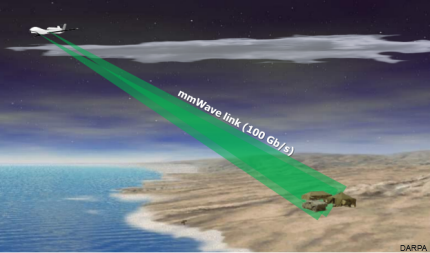DARPA moves ahead on long-range 100 Gbps wireless links
The agency's program is looking to develop links about 500 times faster than the military's current wireless connections.

Pentagon researchers are taking the next step in developing an airborne wireless link that can transmit data at 100 gigabits per second over long distances.
The Defense Advanced Research Projects Agency has issued a Broad Agency Announcement for Phases 2 and 3 of the project, which could issue up to two awards totaling $27 million. The goal is to hit 100 Gbps across 100 kilometers (62 miles) for an air-to-ground link and 200 kilometers (124 miles) for an air-to-air link, each within a single radio-frequency channel.
Six contractors—Northrop Grumman, Raytheon, Battelle Memorial Institute, Silvus Technologies, Trex Enterprises and Applied Communication Sciences— took part in Phase 1 of the program, which explored high-order modulation at millimeter-wave frequencies and spatial multiplexing as the foundations for achieving 100 Gbps. Phase 1 technologies achieved rates in excess of 25 Gbps on a single carrier and 50 Gbps with dual polarization, DARPA said, showing the potential for 100 Gbps.
How fast is 100 Gbps? In October 2013, German researchers managed that speed, which was at the time declared to be a world record for wireless transmission, 10 times faster than Google Fiber. But that was in a lab, using lasers combined with electronics. So getting to 100 Gbps in the air over long distances would be quite a feat.
Basically, DARPA wants to provide forces in the field with the kind of connectivity they would get from a fiber optic network, but do it wirelessly. That 100 Gbps speed would be about 500 times faster than the military’s current wireless connections.
In the next phases of DARPA’s program, researchers will seek to develop a prototype airborne data link capable of being installed in a high-altitude aerial platform, operating at up to 60,000 feet, and functioning in all weather conditions, regardless of rain, fog or clouds. The system will include both airborne and ground nodes, with the airborne node’s size, weight and power requirements being compatible with high-altitude unmanned aircraft, DARPA said.
Although the program’s focus is on data link technologies, rather than airborne networking, the prototype still should be compatible with airborne networking protocols, DARPA said. It must, for instance, support military intelligence, surveillance and reconnaissance (ISR) payloads.
Phase 2 testing will focus on showing the viability of the airborne node hardware and the performance of the airborne and ground nodes, with field testing at a facility such as Naval Air Weapons Station China Lake in California’s Western Mojave Desert. In Phase 3, contractors will select a suitable test aircraft and conduct at least two multi-week flight tests of both the aerial and ground nodes. While the goal is to operate at 60,000 feet, the Phase 3 tests will be conducted at 12,000 feet in order to allow for a greater range of aircraft.
The six contractors that worked on Phase 1 won their contracts in 2013. Phases 2 and 3 will bring the number of contractors down to two.



